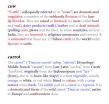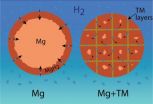(Press-News.org) In an effort to understand what happens in the brain when a person reads or considers such abstract ideas as love or justice, Princeton researchers have for the first time matched images of brain activity with categories of words related to the concepts a person is thinking about. The results could lead to a better understanding of how people consider meaning and context when reading or thinking.
The researchers report in the journal Frontiers in Human Neuroscience that they used functional magnetic resonance imaging (fMRI) to identify areas of the brain activated when study participants thought about physical objects such as a carrot, a horse or a house. The researchers then generated a list of topics related to those objects and used the fMRI images to determine the brain activity that words within each topic shared. For instance, thoughts about "eye" and "foot" produced similar neural stirrings as other words related to body parts.
Once the researchers knew the brain activity a topic sparked, they were able to use fMRI images alone to predict the subjects and words a person likely thought about during the scan. This capability to put people's brain activity into words provides an initial step toward further exploring themes the human brain touches upon during complex thought.
"The basic idea is that whatever subject matter is on someone's mind -- not just topics or concepts, but also, emotions, plans or socially oriented thoughts -- is ultimately reflected in the pattern of activity across all areas of his or her brain," said the team's senior researcher, Matthew Botvinick, an associate professor in Princeton's Department of Psychology and in the Princeton Neuroscience Institute.
"The long-term goal is to translate that brain-activity pattern into the words that likely describe the original mental 'subject matter,'" Botvinick said. "One can imagine doing this with any mental content that can be verbalized, not only about objects, but also about people, actions and abstract concepts and relationships. This study is a first step toward that more general goal.
"If we give way to unbridled speculation, one can imagine years from now being able to 'translate' brain activity into written output for people who are unable to communicate otherwise, which is an exciting thing to consider. In the short term, our technique could be used to learn more about the way that concepts are represented at the neural level -- how ideas relate to one another and how they are engaged or activated."
The research, which was published Aug. 23, was funded by a grant from the National Institute of Neurological Disease and Stroke, part of the National Institutes of Health.
Depicting a person's thoughts through text is a "promising and innovative method" that the Princeton project introduces to the larger goal of correlating brain activity with mental content, said Marcel Just, a professor of psychology at Carnegie Mellon University. The Princeton researchers worked from brain scans Just had previously collected in his lab, but he had no active role in the project.
"The general goal for the future is to understand the neural coding of any thought and any combination of concepts," Just said. "The significance of this work is that it points to a method for interpreting brain activation patterns that correspond to complex thoughts."
Tracking the brain's 'semantic threads'
Largely designed and conducted in Botvinick's lab by lead author and Princeton postdoctoral researcher Francisco Pereira, the study takes a currently popular approach to neuroscience research in a new direction, Botvinick said. He, Pereira and coauthor Greg Detre, who earned his Ph.D. from Princeton in 2010, based their work on various research endeavors during the past decade that used brain-activity patterns captured by fMRI to reconstruct pictures that participants viewed during the scan.
"This 'generative' approach -- actually synthesizing something, an artifact, from the brain-imaging data -- is what inspired us in our study, but we generated words rather than pictures," Botvinick said.
"The thought is that there are many things that can be expressed with language that are more difficult to capture in a picture. Our study dealt with concrete objects, things that are easy to put into a picture, but even then there was an interesting difference between generating a picture of a chair and generating a list of words that a person associates with 'chair.'"
Those word associations, lead author Pereira explained, can be thought of as "semantic threads" that can lead people to think of objects and concepts far from the original subject matter yet strangely related.
"Someone will start thinking of a chair and their mind wanders to the chair of a corporation then to Chairman Mao -- you'd be surprised," Pereira said. "The brain tends to drift, with multiple processes taking place at the same time. If a person thinks about a table, then a lot of related words will come to mind, too. And we thought that if we want to understand what is in a person's mind when they think about anything concrete, we can follow those words."
Pereira and his co-authors worked from fMRI images of brain activity that a team led by Just and fellow Carnegie Mellon researcher Tom Mitchell, a professor of computer science, published in the journal Science in 2008. For those scans, nine people were presented with the word and picture of five concrete objects from 12 categories. The drawing and word for the 60 total objects were displayed in random order until each had been shown six times. Each time an image and word appeared, participants were asked to visualize the object and its properties for three seconds as the fMRI scanner recorded their brain activity.
Matching words and brain activity with related topics
Separately, Pereira and Detre constructed a list of topics with which to categorize the fMRI data. They used a computer program developed by Princeton Associate Professor of Computer Science David Blei to condense 3,500 articles about concrete objects from the online encyclopedia Wikipedia into all the topics the articles covered. The articles included a broad array of subjects, such as an airplane, heroin, birds and manual transmission. The program came up with 40 possible topics -- such as aviation, drugs, animals or machinery -- with which the articles could relate. Each topic was defined by the words most associated with it.
The computer ultimately created a database of topics and associated words that were free from the researchers' biases, Pereira said.
"We let the software discern the factors that make up meaning rather than stipulating it ourselves," he said. "There is always a danger that we could impose our preconceived notions of the meaning words have. Plus, I can identify and describe, for instance, a bird, but I don't think I can list all the characteristics that make a bird a bird. So instead of postulating, we let the computer find semantic threads in an unsupervised manner."
The topic database let the researchers objectively arrange the fMRI images by subject matter, Pereira said. To do so, the team searched the brain scans of related objects for similar activity to determine common brain patterns for an entire subject, Pereira said. The neural response for thinking about "furniture," for example, was determined by the common patterns found in the fMRI images for "table," "chair," "bed," "desk" and "dresser." At the same time, the team established all the words associated with "furniture" by matching each fMRI image with related words from the Wikipedia-based list.
Based on the similar brain activity and related words, Pereira, Botvinick and Detre concluded that the same neural response would appear whenever a person thought of any of the words related to furniture, Pereira said. And a scientist analyzing that brain activity would know that person was thinking of furniture. The same would follow for any topic.
Using images to predict the words on a person's mind
Finally, to ensure their method was accurate, the researchers conducted a blind comparison of each of the 60 fMRI images against each of the others. Without knowing the objects the pair of scans pertained to, Pereira and his colleagues estimated the presence of certain topics on a participant's mind based solely on the fMRI data. Knowing the applicable Wikipedia topics for a given brain image, and the keywords for each topic, they could predict the most likely set of words associated with the brain image.
The researchers found that they could confidently determine from an fMRI image the general topic on a participant's mind, but that deciphering specific objects was trickier, Pereira said. For example, they could compare the fMRI scan for "carrot" against that for "cow" and safely say that at the time the participant had thought about vegetables in the first example instead of animals. In turn, they could say that the person most likely thought of other words related to vegetables, as opposed to words related to animals.
On the other hand, when the scan for "carrot" was compared to that for "celery," Pereira and his colleagues knew the participant had thought of vegetables, but they could not identify related words unique to either object.
One aim going forward, Pereira said, is to fine-tune the group's method to be more sensitive to such detail. In addition, he and Botvinick have begun performing fMRI scans on people as they read in an effort to observe the various topics the mind accesses.
"Essentially," Pereira said, "we have found a way to generally identify mental content through the text related to it. We can now expand that capability to even further open the door to describing thoughts that are not amenable to being depicted with pictures."
INFORMATION:
Word association: Princeton study matches brain scans with complex thought
2011-09-01
ELSE PRESS RELEASES FROM THIS DATE:
Iron 'Veins' Are Secret of Promising New Hydrogen Storage Material
2011-09-01
With a nod to biology, scientists at the National Institute of Standards and Technology (NIST) have a new approach to the problem of safely storing hydrogen in future fuel-cell-powered cars. Their idea: molecular scale "veins" of iron permeating grains of magnesium like a network of capillaries. The iron veins may transform magnesium from a promising candidate for hydrogen storage into a real-world winner.
Hydrogen has been touted as a clean and efficient alternative to gasoline, but it has one big drawback: the lack of a safe, fast way to store it onboard a vehicle. ...
Registration Opens September 1 for 4th Annual Renton FilmFrenzy, a 50-Hour Filmmaking Competition with $1,700 in Cash Prizes; Filmmakers will Take Over Renton from Oct. 7-9
2011-09-01
It will be "lights, camera, action" in Renton from October 7-9, when aspiring, ahead of the curve filmmakers take over the city for the fourth annual Renton FilmFrenzy, a 50-hour filmmaking competition. Last year, 25 filmmaking teams competed for $1,700 in cash prizes and the coveted Curvee Awards.
"Thanks to our partnerships with SIFF, Reel Grrls, theFilmSchool, area filmmaking programs, and the Renton Arts Commission, the Renton FilmFrenzy continues to expand and has become an integral part of the growing and strong Renton arts community," said ...
Sandfly saliva provides important clues for new Leishmaniasis treatments
2011-09-01
Bethesda, MD—For millions of people who live under the constant threat of Leishmania infection, a new discovery by Brazilian scientists may lead to new breakthroughs, preventing these parasites from taking hold in the body or reducing the severity of infections once they occur. In a new report appearing in the Journal of Leukocyte Biology (http://www.jleukbio.org), scientists show that specific molecules found in the saliva of the sandfly—a small flying insect that is the vector for the parasite—make it possible for Leishmania to evade neutrophils and live within human ...
Celebrate the Seventh Annual Cobra Polo Classic Benefiting Ronald McDonald House Charities
2011-09-01
Polo is possibly the oldest sport, period. The first experience with a mallet, pony and a round object were recorded nearly two thousand years ago. Polo is the sport known to royalty around the world.
On Sunday, September 11th over twelve-hundred guests will celebrate the seventh annual Cobra Polo Classic benefiting Ronald McDonald House Charities of Spokane. "It is the most prestigious event in the Inland Northwest," reports Mike Forness, RMHC of Spokane Executive Director. Sky divers, gourmet food and wine, cigar and Dry Fly whiskey tent, safari escape women's ...
SER2011 Mexico call to action
2011-09-01
The delegates of the Society for Ecological Restoration´s 4th World Conference on Ecological Restoration (SER2011) congratulate the Parties of the Convention on Biological Diversity (CBD) for their practical and forward looking Strategic Plan 2011-2020, including Targets 14 and 15 in which the Parties have agreed that by 2020, ecosystems of particular importance to water security, human health, and sustainable livelihoods are restored, and their resilience and contribution to carbon stocks enhanced, through conservation and restoration, including the restoration of at ...
2011 AAO-HNSF new oral research daily highlights
2011-09-01
San Francisco, CA – The 2011 Annual Meeting & OTO EXPO of the American Academy of Otolaryngology – Head and Neck Surgery Foundation (AAO-HNSF), the largest meeting of ear, nose, and throat doctors in the world, will convene September 11-14, 2011, in San Francisco, CA.
Featuring more than 386 scientific research sessions, 468 posters, and several hundred instruction course hours for attendees, the annual meeting is a unique opportunity for journalists from around the world to cover breaking science and medical news. Reporters will have access to the latest research and ...
Scientists unravel the cause of rare genetic disease: Goldman-Favre Syndrome explained
2011-09-01
Bethesda, MD—A new research report published in The FASEB Journal (https://www.fasebj.org) will help ophthalmologists and scientists better understand a rare genetic disease that causes increased susceptibility to blue light, night blindness, and decreased vision called Enhanced S-Cone Syndrome or Goldman-Favre Syndrome. In the report, scientists found that the expression of genes responsible for the healthy renewal of rods and cones in the retina was reduced and that this problem originates in the photoreceptors themselves rather than in the adjacent retinal pigment epithelial ...
'Pink ribbon dollars' help fill financial gaps for breast cancer programs
2011-09-01
A new study shows that donations collected by check boxes on state income tax forms, fees from license plates and revenue from state lottery tickets have raised millions for breast cancer research and prevention programs across the country, according to researchers at Washington University in St. Louis.
"We found that revenue-generating breast cancer initiatives can be a successful strategy for states to raise funds, or 'pink ribbon dollars,' for prevention and early detection programs," says Amy A. Eyler, PhD, research associate professor at the Brown School of Social ...
Carlsbad, New Mexico, to Host National Nuclear Fuel Cycle Summit
2011-09-01
The Carlsbad Department of Development (CDOD) has announced the first annual National Nuclear Fuel Cycle Summit, taking place April 2-5, 2012. The Summit will be hosted by Carlsbad, New Mexico, and will include renowned experts from the various nuclear-related industries across the nation.
Panel discussions will provide members of the public and policymakers with valuable insights into and strategies addressing our national nuclear fuel cycle policies, our nation's growing energy needs, nuclear waste management, regulation, and funding. A lively discussion on the highly ...
Cracking cellulose: a step into the biofuels future
2011-09-01
Scientists from the University of York have played a pivotal role in a discovery which could finally unlock the full potential of waste plant matter to replace oil as a fuel source.
Professor Paul Walton and Professor Gideon Davies, of the University's Department of Chemistry, were part of an international team that has found a method to overcome the chemical intractability of cellulose, thus allowing it to be converted efficiently into bioethanol.
Working with scientists in Novozymes laboratories at Davis, California, and Bagsvaerd, Denmark, as well as researchers ...


